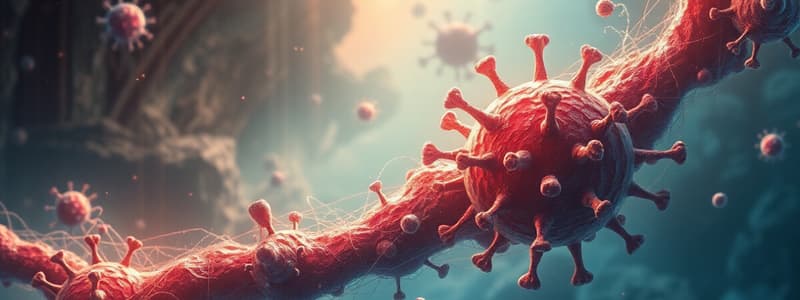Podcast
Questions and Answers
What function do antimicrobial peptides (AMPs) serve in the first line of defense?
What function do antimicrobial peptides (AMPs) serve in the first line of defense?
- Increase the pH level in the stomach
- Enhance the activity of macrophages
- Stimulate the production of T cells
- Disrupt bacterial membranes to kill bacteria (correct)
What is the role of lysozymes in the chemical barriers of the first line of defense?
What is the role of lysozymes in the chemical barriers of the first line of defense?
- Cleaves glycosidic bonds between NAG and NAM in bacterial cell walls (correct)
- Regulate the skin's pH level
- Boost the immune response of T cells
- Prevent the entry of pathogens through mucous membranes
Which cells are primarily involved in the innate immune response?
Which cells are primarily involved in the innate immune response?
- Cilia
- Dendritic cells (correct)
- B cells
- T cells
What characteristic distinguishes acquired immunity from innate immunity?
What characteristic distinguishes acquired immunity from innate immunity?
How do phyically and chemically designed barriers contribute to immune defense?
How do phyically and chemically designed barriers contribute to immune defense?
What is the primary mode of action for psoriasin, an antimicrobial peptide produced by keratinocytes?
What is the primary mode of action for psoriasin, an antimicrobial peptide produced by keratinocytes?
Which component is primarily responsible for maintaining the skin's barrier while eliminating harmful pathogens?
Which component is primarily responsible for maintaining the skin's barrier while eliminating harmful pathogens?
What is the significance of normal microflora in the first line of defense?
What is the significance of normal microflora in the first line of defense?
Flashcards
First Line of Defence
First Line of Defence
The body's initial barriers to prevent pathogens from entering.
Physical Barriers
Physical Barriers
Physical structures that prevent pathogen entry.
Skin
Skin
A tough outer layer, acting as a barrier, and containing keratinocytes.
Mucous Membranes
Mucous Membranes
Signup and view all the flashcards
Chemical Barriers
Chemical Barriers
Signup and view all the flashcards
Lysozyme
Lysozyme
Signup and view all the flashcards
AMPs (Antimicrobial Peptides)
AMPs (Antimicrobial Peptides)
Signup and view all the flashcards
pH
pH
Signup and view all the flashcards
Normal Microbiota
Normal Microbiota
Signup and view all the flashcards
Expulsive Reflexes
Expulsive Reflexes
Signup and view all the flashcards
Study Notes
First Line of Defence
- Physical Barriers:
- Skin: Acts as a barrier, preventing pathogen entry. Multiple layers of tightly packed epithelial cells and dead keratinocytes in the outer layer. The dermis contains immune cells. Slightly acidic pH, high salt concentration, and dryness inhibit microbial growth. Constant shedding removes pathogens.
- Epithelial Lining: Forms a barrier and identifies pathogen presence. Mucous and cilia trap and remove pathogens.
- Expulsive Reflexes: Coughing, sneezing, and vomiting remove pathogens from the body.
- Chemical Barriers:
- pH: High acidity in the stomach and on the skin inhibits pathogen growth. Saliva contains lysozymes.
- Lysozymes: Enzymes that break down bacterial cell walls by cleaving the sugar backbone, causing cell lysis (bursting).
- Antimicrobial Peptides (AMPs): Found in skin, saliva, and siderophores. Positively charged and hydrophobic, targeting bacterial membranes. Examples include psoriasin, defensins, and lactoferricin.
- Psoriasin: Disrupts bacterial membranes, sequesters zinc, and is effective against Gram-negative bacteria. Maintains skin barrier homeostasis.
- Defensins: Short peptides that create pores in bacterial membranes, leading to depolarization and cell death. Effective against diverse pathogens like E. coli, Streptococcus, and Pseudomonas.
- Lactoferrin: Binds iron, depriving bacteria of essential nutrient, inhibiting their growth and survival. Cleaved into smaller AMPs by enzymes.
- Normal Microflora: Indigenous microorganisms that compete with pathogens for resources.
Innate Immunity
- Rapid and Non-Specific: The second line of defence. Includes cells like macrophages, natural killer (NK) cells, and dendritic cells.
Acquired Immunity
- Slow, Long-lasting, and Highly Specific: The third line of defence. Involves lymphocytes such as B cells and T cells.
Studying That Suits You
Use AI to generate personalized quizzes and flashcards to suit your learning preferences.




